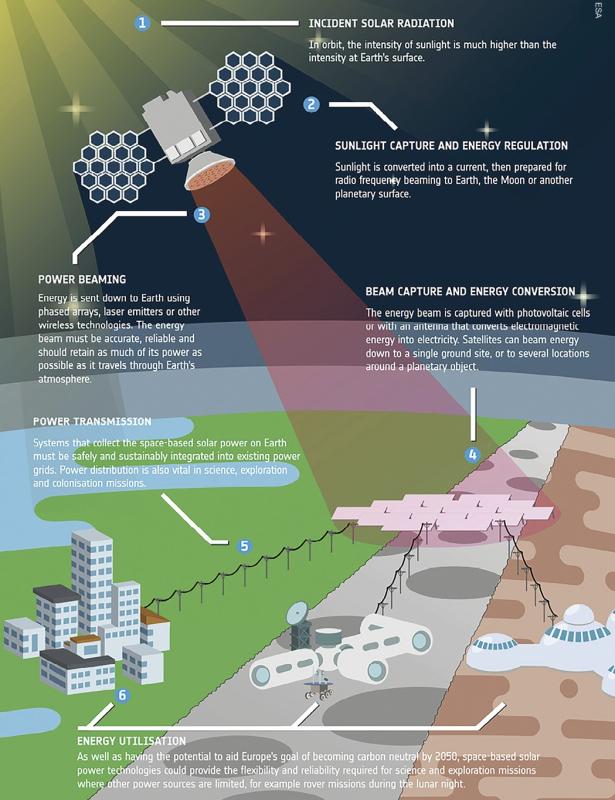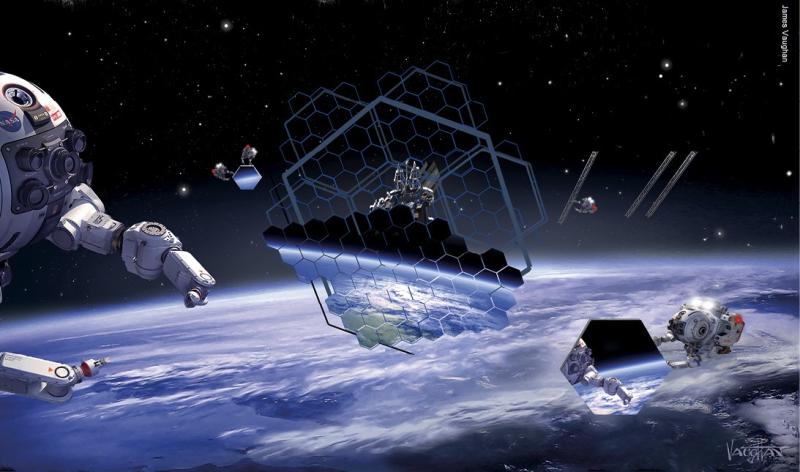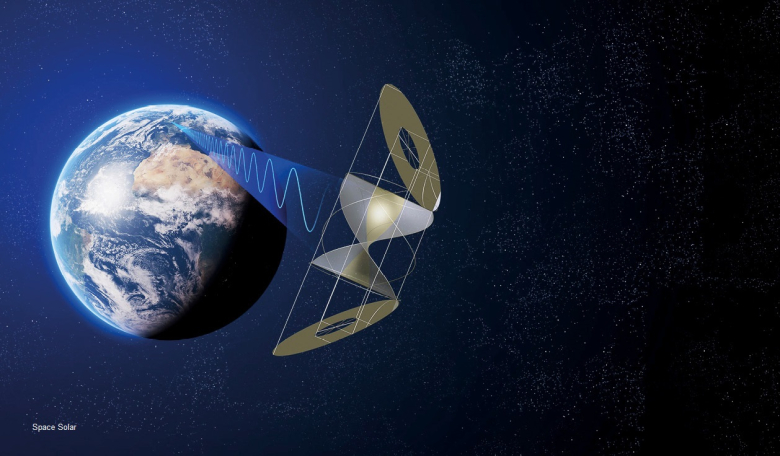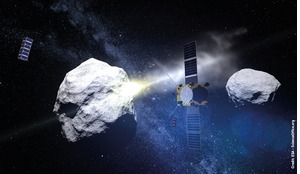Space-based solar power is attracting a significant amount of interest and excitement for the role it can play in the world’s transition to sustainable energy sources. The impact that this technology will have for the NewSpace economy cannot be understated and here the authors explore how space-based solar power will accelerate existing services and unlock previously unimaginable business opportunities.
Space-based solar power (SBSP) first made its appearance in literature in 1941 when Isaac Asimov, in his short story Reason, described a space station that harvests energy in space and wirelessly transmits it to Earth. Peter Glaser picked this up again at the height of the race to space, in the journal Science, titled ‘Power from the sun: its future’, in 1968.
The concept is deceptively simple: convert solar power in space - where it is in unattenuated, abundant and in constant supply - to microwaves, which can be beamed to a receiver on Earth with minimal atmospheric losses, resulting in gigawatt-scale baseload power.
In recent decades, multiple organisations, nations and individuals have proposed and researched various possible solar power satellite (SPS) designs that tackle the rotation conundrum: the solar cells always need to see the Sun and the microwaves always need to point to Earth.
Leading designs for gigawatt-scale power from geosynchronous orbits include SSPS (USA), SPS-ALPHA (USA), MR-SPS (China), Tethered SPS (Japan) and CASSIOPeiA (UK).
The physics of wireless power transmission at microwave frequencies also determines another characteristic feature of these gigawatt-scale designs: they are all at least several kilometres in size. For example, SPS-ALPHA would stretch over approximately 13 km with a diameter in excess of 6 km.
 A visual imagination of the SBSP ecosystem opportunity.
A visual imagination of the SBSP ecosystem opportunity.
CASSIOPeiA is more compact, but still approximately 6 km long and 2 km diameter. These SPS structures will dwarf anything currently in space, the largest structure being the International Space Station with dimensions of around 100 m.
Space-based solar power is the sustainable replacement the world needs
The surge of excitement in SBSP is driven by recent techno-economic studies for NASA, the European Space Agency (ESA) and the UK Space Agency (UKSA) which have concluded that SBSP is both technically and economically feasible. Such conclusions are driven by advances in robotics, decreasing hardware costs and, most significantly, decreasing launch costs, due to the emergence of reusable and more sustainable rockets.
This is fortuitous timing to say the least. Our world’s hunger for energy is growing, yet the majority of current baseload technologies rely on fossil fuels. Space-based solar power is the sustainable replacement the world needs.
The UK’s Space Energy Initiative, as well as startups such as Space Solar, have plans for SBSP to be commercially available within 15 years. The International Energy Authority’s (IEA) projection of global electricity demand by 2050 is 50,000 TWh or 5707 GW (gigawatts). A conservative estimate for the share addressable by SBSP is around 20 percent, or 10,000 TWh (1141 GW). For an average system size of 2 GW, that would mean a demand for approximately 570 SPS in geosynchronous (GSO) or geostationary (GEO) orbits.
According to the IEA, to hit ‘Net Zero’ by 2050 the world will need to increase its production of minerals - such as lithium, copper, nickel and the rare earth elements - sixfold. Due to its sparse nature and ability to use high concentration photovoltaics, SBSP would need significantly fewer rare minerals, compared to a similar sized terrestrial solar farm. It also uses less land than renewables for equivalent power output: just 40 percent of terrestrial solar and eight percent of offshore wind.
It is also important to note that any single SPS in a geostationary orbit can see a quarter of the globe and in an instant can move its beam from one location to another. The ability for instantaneous, dispatchable power without the need for expensive resource-hungry interconnects could make an incredibly important contribution to balancing humanity’s power needs as we become increasingly reliant on renewables.
Ecosystem opportunity
The realisation of SBSP would dramatically impact the space ecosystem and accelerate other developments already under way. First and foremost, it would become the biggest single heavy launch customer for several decades. As such it would become the first large infrastructure project to benefit from these vehicles, paving the way for others in the future. Each SPS requires 50-100 launches. With, potentially, multiple SBSP developers intending to commission one or two systems per year, this would imply several launches per week, likely from multiple global sites.
No single heavy launch provider is likely to be able to fulfill such an order book and so there will be opportunities for several commercial players to step in. Strong market forces will thus drive down inefficiencies in hardware and operations.
Launch, however, is only the start of the component journey to the SPS construction site in orbit. Space freight providers with their orbital transfer vehicles (OTV) will need to pick up cargo from the launch vehicle and transport it to the right place. Whether this is a single or multi-stage OTV, or whether there is a handover, may differ from provider to provider. At any point in time, there could be several hundred OTVs shuttling cargo to multiple SPS construction sites.
Both in the case of launch and OTVs, and thus space freight in general, single use machinery would be detrimental to operational costs and the general sustainability of the whole operation, including SBSP.
Reusable systems
There is an imperative to create an in-space circular economy, with in-orbit component swapping and repairing, in-orbit material recycling and processing
Reusable systems and in-space refuelling systems would need to be deployed at scale. That means there would be a commercial opportunity for in-space refuelling infrastructure, both chemical and electrical.
Planning in-orbit servicing and maintenance missions is difficult as the original satellites were never designed to be maintained. SBSP will be designed for this and help to pave the way for new international in-orbit service standards and industry-standard interfaces.
As these space shipping containers arrive at the SPS construction site, they will need to be docked, the contents unpacked and the SPS assembled. This will need to be performed with semi-autonomous robots, operating on a ‘human by exception’ basis - the time lag would make teleoperations incredibly difficult.
Training these artificial intelligence (AI)systems will require virtual training grounds to generate a whole host of random scenarios, as they don’t have the benefit of just making a test drive like autonomous cars. Over time assembly will become more and more autonomous.
Warehouse-style logistics
The robotic hardware required is unlike current space robotics and would be more akin to warehouse or logistics ‘pick and pack’, or automotive assembly robotics. In a hypermodular manufacturing approach the more complex components would be created on Earth and the relatively easy plug & play Close Proximity Operations (CPO) in space.
The demand for this development will be driven by SBSP and it will unlock routine satellite servicing missions. The implication is that satellite design can be revolutionised: not design for de-orbit, but design for maintenance, for upgrades, providing the blueprint for a cislunar circular economy.
An SPS asset would also need security, including cybersecurity, typical of any terrestrial Critical National Infrastructure (CNI). This would need to protect the SPS from unwanted inspections, avoidable collisions and other physical threats.
While the response cannot be aggressive, as per the Outer Space Treaty, knowing what is happening nearby will be paramount. Multiple ‘guard dog’ spacecraft can be expected to patrol the vicinity of the SPS, to enable early detection, identification and possible deterrence of suspicious, nefarious or dangerous activity.
While the focus of the above may appear only technical, there is also a significant new opportunity around contracts, liabilities and insurance along each step of the way. A new ecostructure will be created (see diagram opposite).
New business opportunities
The robotic hardware required is unlike current space robotics and would be more akin to warehouse or logistics ‘pick and pack’
With such a large asset in space there are new possible business opportunities that could be capitalised upon.
The first one would be instrumenting the OTVs - what else could they do as they journey through space, back and forth to the construction site? Sensors could be mounted on the OTVs to collect information about, for example, debris, radiation, space weather and the status of satellites along the path - all with unprecedented position and frequency.
Secondly, simply placing broken components or even whole SPS infrastructure in graveyard orbits will not be sustainable.
There is an imperative to create an in-space circular economy, with in-orbit component swapping and repairing, in-orbit material recycling and processing or, perhaps, lunar processing and thus kick-start the lunar economy. Any materials not recyclable in orbit, should be returned to Earth for reprocessing here. This would also create a freight opportunity: in-space scrap collection and space planes to bring back materials.
With an asset that can be positioned anywhere in space or around any planet, it becomes possible to not just power the Earth, but provide surface power to the space stations, the Moon, other planets or even asteroids.
This makes activities, especially in-situ resource utilisation, far more attractive, rather than just relying on surface solar or nuclear power.
Spacecraft on exploration missions powered by electric propulsion could be given an additional SBSP-provided boost during their accelerating phase. This means that their transit propulsion systems could be reduced in size, allowing more space for payload instruments for the target mission.

Future steps
The next decade will be a defining one for humanity and the need for reliable and equitable high energy density will be critical, perhaps even to the survival of civilisation as we have come to know it.
The opportunity for SBSP is therefore hugely significant. It will support the Net Zero transition and will accelerate the cislunar economy, including the rollout of other in-space infrastructure and services.
SBSP will unlock a marketplace for a whole host of new services, providing the cornerstone for the NewSpace and off-world economy, including for robots in space facilitating the energy provision on Earth, just like Asimov predicted. It is no longer a question of whether SBSP will become a reality - it is now only a question of when.
 Reusable and robotic systems will play a key role inthe future construction of any space-based solar power systems.
Reusable and robotic systems will play a key role inthe future construction of any space-based solar power systems.
About the authors
Frank Schoofs is a Senior Space Energy Development Engineer with the UK Satellite Applications Catapult. He previously worked with the UK Atomic Energy Authority. He has a PhD in Materials Science, University of Cambridge (UK) and a Masters in Engineering, Materials Engineering, from KU Leuven (Belgium). He is a Chartered Engineer and a Fellow of the Institute of Materials, Minerals and Mining
David A Homfray is Chief Technology Officer at Space Solar with the primary responsibility of designing and delivering the Space Solar technical programme, enabling SBSP products to be delivered at scale to meet Net Zero. He is a Chartered Physicist, Chartered Engineer and a Fellow of the Institute of Physics.














